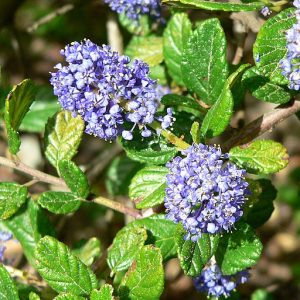A splendid spring flowering California native shrub from the chaparral zones is the wild lilac, or Ceanothus. They are also called blue blossoms, although flowers can be pink, white, and every blue from sky to purple. In size, varieties range from spreading groundcovers, mounding or arching shrubs, to small trees. What they share is an enthusiastic spring bloom, evergreen dark to mid-green foliage, and drought hardiness.
All ceanothus require well-drained sites and lots of sun for good bloom. Once established, a few deep summer waterings will keep them happy. Certain varieties can naturalize in reasonably deep soil and live for years on only our natural winter and spring rains. A few garden selections even tolerate summer water and perform well in normal garden settings. Sunset Western Garden Book gives a good list of varieties and their expected sizes.
The best practice is to match the size of the plant with the site it is expected to fill. A little early pruning to shape the shrub at the start is all that is required. While a few varieties can be pruned into a hedge, most have a tidy habit and require little assistance to stay attractive.
In a native landscape plan, good companions are the Western redbud or Cercis occidentalis, coffeeberry or Rhamnus californica ‘Eve Case,’ the manzanita Arctostaphylos ‘Howard McMinn,’ and deer grass Muhlenbergia rigens. A favorite very deer-resistant landscape combination is the Ceanothus ‘Dark Star’ with the silvery foliage lavender ‘Fred Boutin.’
Some varieties of ceanothus are more deer-resistant than others. Usually, the spiny ‘holly-leafed’ varieties like C. ‘Blue Jeans,’ C. gloriosus ‘Anchor Bay,’ and C. g. exaltatus ‘Emily Brown’ seem to best avoid browsing. Also, C. ‘Dark Star,’ with tiny leathery dark green leaves, is practically deer-proof. Some of the taller varieties, like ‘Concha’ and ‘Frosty Blue,’ which may not be as deer resistant, can be grown with protection until they exceed Bambi’s reach. Or try under-planting your favorite ceanothus with a deer-proof companion like Salvia clevelandii, the native fragrant sage. Again, if the plant is watered and fed through the summer, postponing its natural period of summer dormancy, it will be more attractive to wildlife. Mama Nature’s style, with no summer irrigation, results in a slower growing, tougher shrub, although it may look a bit stressed. In a home landscape, I aim at a happy medium, watering deeply and infrequently.
You may find many varieties of this lovely California native at various native plant nurseries (remember, the time to plant California natives is in the fall) and online nurseries such as High Country Gardens and Las Pilitas Nursery. Advice on which variety will best meet the requirements of your site can also be obtained from members of the California Native Plant Society (http://www.sierrafoothillscnps.org/).
Mary Anderson propagates many native plants from the seeds of her ‘mother plants’ and is one of the original members of the Sierra Foothills Chapter of the California Native Plant Society.



